Spring is almost here and I am starting to daydream already of the new plants we will have for this year. I am also looking forward to the return of my favourite perennials after their winter slumber, gracing our garden again with their lovely presence. And one of these perennials I'm looking forward to seeing again are the Persicarias.
Persicarias, persicarias! They are definitely one of my favourite group of plants in the garden. There are different types of course, with different habits and appearances but the ones with beautifully marked and patterned foliage I am particularly fond of.
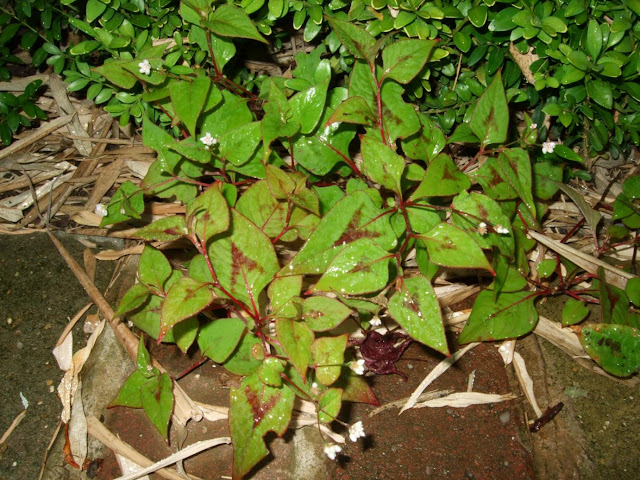 |
| Persicaria sp. Kunming |
In an exotic garden like ours, warm, bright, and contrasting foliage colour are essential in helping to imbibe that 'tropical feel' in certain parts of the garden. We can use lots of tender annuals of course for that injection of colour and contrast but it's more fun to cheat by using plants that are perfectly hardy, and yet can give much the same look as these tender exotics would.
Persicarias with marked, variegated, patterned, and colourful leaves certainly fits the bill! As the title of this blog suggests, some of them look like their leaves have been painted on, or rather stencilled with a regular pattern, or even randomly splashed away with creamy coloured paint. All done by mother nature of course, and for me all very pretty.
Here are some of the foliage persicarias that we grow in our garden:
Persicaria microcephala 'Red Dragon'
This is possibly the most popular of all the foliage persicarias and is available on most garden centres in the UK. The rich colour of the leaves that vary in shade and intensity throughout the growing season makes it so popular amongst gardeners. And it's versatile too, associating well with other plants and various other planting schemes. I've heard comments that this plant can be too vigorous on milder parts of the country but for most gardeners this a well behaved, clumping plant that is easy enough to keep under control if it ever outgrows its space.
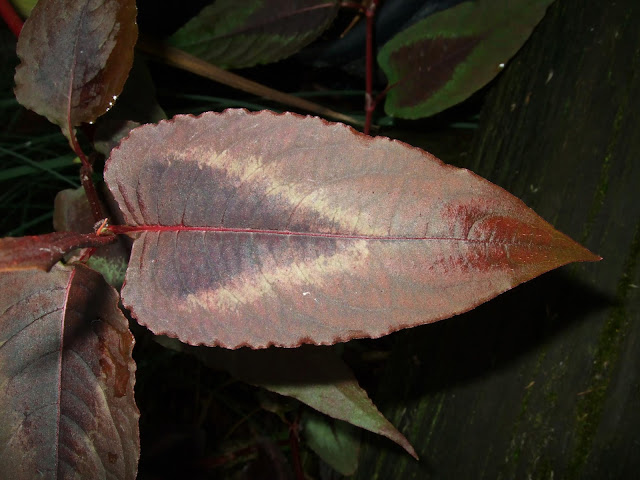 |
| Persicaria microcephala 'Red Dragon' |
Persicaria virginiana var. filiformis
If I have to choose among this group which one is my favourite it will have to be this one. The leaves are on the large side for a persicaria, fresh green with a slight sheen to the surface. Its best feature though is the uniform, deep maroon chevron marking that are consistent on each individual leaf which makes it a colourful and elegant plant for the garden. It has remained a tight clump in our garden, unfussy in its growing requirements but performs better in full sun to dappled shade where it grows to a reasonable size. Site it where it will make a good contrast or complement to other foliage plants, but also within good view so you can appreciate its beautiful leaf markings. Highly recommended!
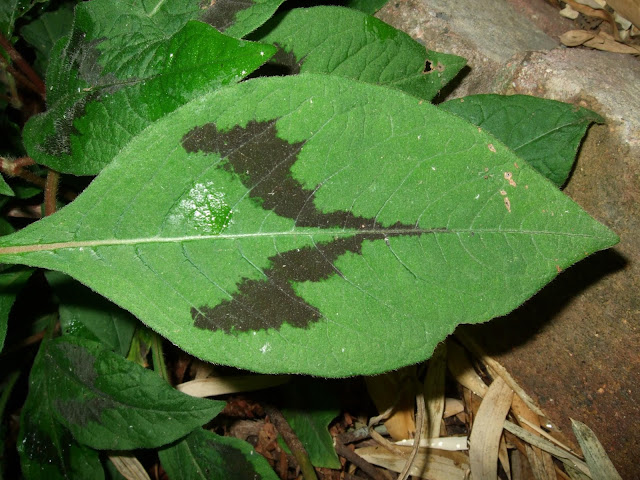 |
| Persicaria virginiana var. filiformis |
Persicaria capitata
A trailing and scrambling persicaria with small, chevron marked leaves with pink flowers sent out in succession all summer long. It can be used as a ground cover or on pots and hanging baskets where its trailing nature can be appreciated as it hangs out onto the sides of it's container. This can be invasive in favourable and milder locations (like in West Cornwall and Madeira) but in our garden it remains a tight clump and is not vigorous. So far it's more of a minor nuisance in the greenhouse as it self seeds on neighbouring pots but is never a problem outside here.
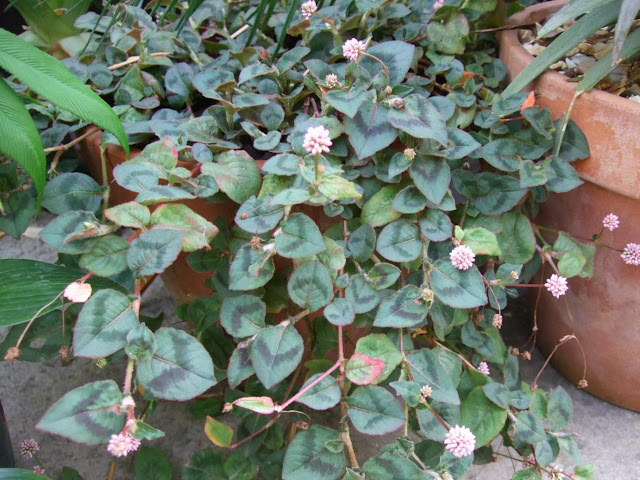 |
| Persicaria capitata |
Persicaria virginiana 'Variegata'
I can almost hear gardeners out there who hate variegated plants scream in anguish at the sight of this but for me I think it is lovely with it's random, cream variegated patterned leaves. It needs to be sited on a bright spot that gets indirect sun to prevent the creamy parts from scorching but at the same time appreciate the brightness of this plant. It also performs just as well planted in shade where it seems to illuminate its own spot. A tight clumper in our garden.
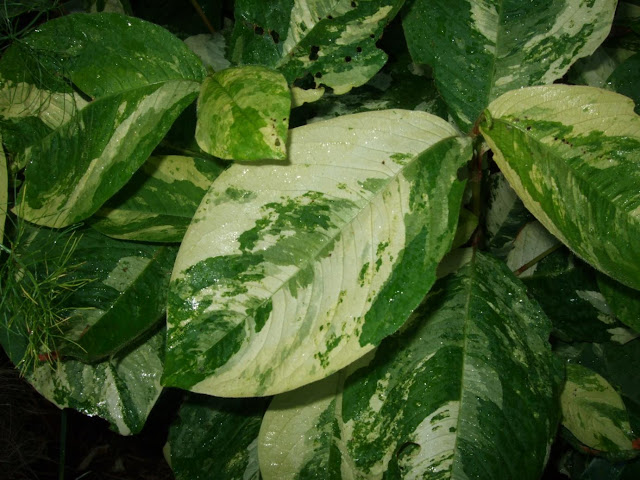 |
| Persicaria virginiana 'Variegata' |
Persicaria sp. Kunming
One of the most, if not the most colourful persicaria you can plant in your garden. The intensity of its colour and markings changes dramatically throughout the season, coming up very intense pink in the spring which lasts for a couple of weeks before toning down to apple green with pink leaf margins and stems in late spring. By early summer the colours and markings intensify again but looking more purple than pink with an attractive gradient, and by midsummer onwards the colour tones down again to apple green but not losing its chevron marking. It also liberally sends out dainty flowers but they are barely noticeable on top of such attractive foliage.
For all it’s beauty do site this plant carefully as it can be rampant and can quickly cover a sizeable area in no time at all, which makes it a great ground cover plant if ever you need one. Even with its vigour I find it easy enough to control by severing and removing wandering rhizomes in the autumn which are fortunately superficial and easy to pull out. Make sure you bin all of the cuttings rather than composting them to prevent unwanted spread. Or you can always just keep it in a pot which will definitely restrict its spread.
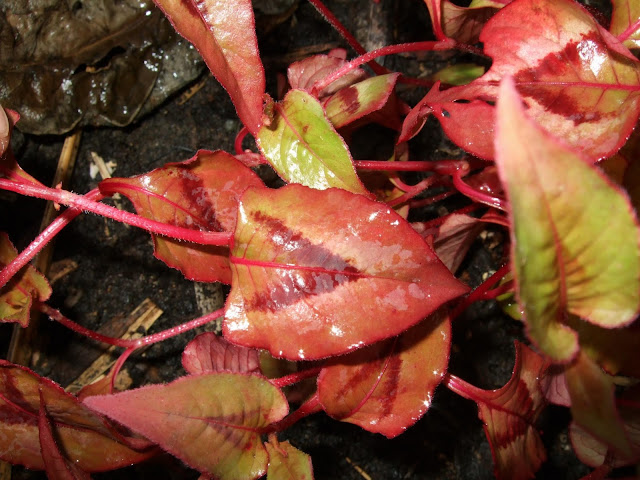 |
| New growth in the spring is very bright, almost fluorescent pink.. |
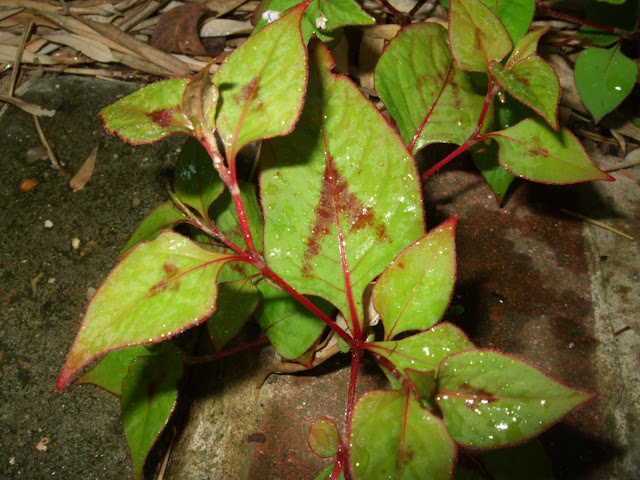 |
| By late spring the pink colour becomes less intense and pattern less marked |
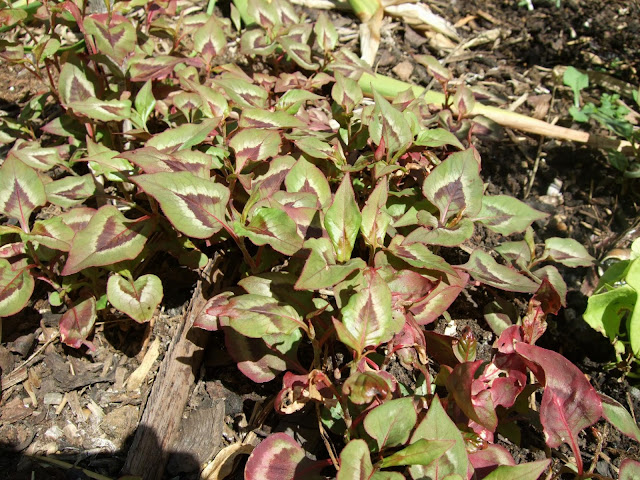 |
| And by midsummer the pattern becomes intense again, this time more maroon/purple with a gradient of colour to the leaves. Lovely! |
Persicaria virginiana 'Painter's Palette'
A very colourful and bright persicaria that combines the variegation pattern 'Variegata' with the maroon chevron marking of Filiformis. You may or may not like this plant for the multitude of colour on its foliage but it certainly does brighten up its spot and adds splashes of colour to any border. This is a popular plant that is often used in cottage style gardens as a contrast to other flowering perennials, and in exotic style gardens for it colourful foliage and exotic appearance.
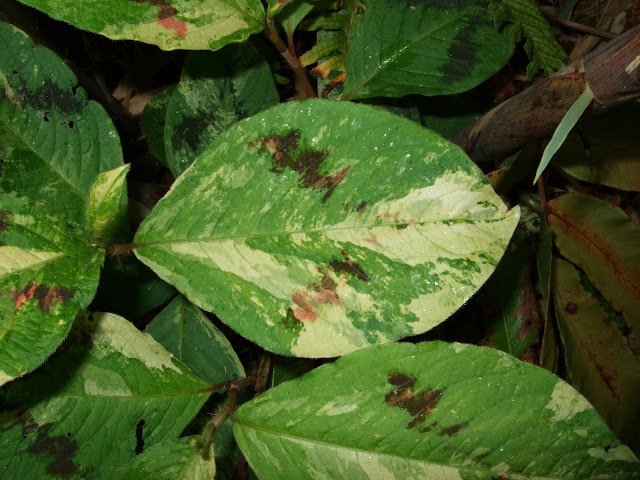 |
| Persicaria virginiana 'Painter's Palette' |
Persicaria runcinata
This is a new one for us and I have yet to try it outside but I’m confident it will be hardy enough for our location. I’ve been after this persicaria for quite some time now after seeing it on various websites based in continental Europe but it seems to be more widely available there than in the UK as I yet to find a source here. Fortunately we were sent several rooted cuttings by a friend from Holland and I’m looking forward to planting this out in the garden. Originating from high altitude parts of Nepal, it’s been reported that this can be invasive on milder areas but can remain clumping elsewhere. I guess I’ll just have to wait and see how it will perform in our garden!
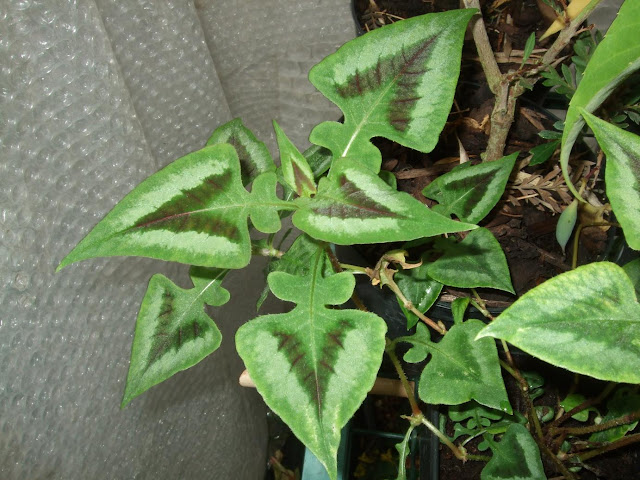 |
| Persicaria runcinata |
Persicaria virginiana 'Compton's Form'
This looks similar to 'Red Dragon' but has bigger, longer leaves and the foliage colour is more brown than purple. Some say that this is more elegant than Red Dragon but to me they look different enough to have their own individual merits. With its bigger foliage and deeper colour it can look very dramatic in contrast with other plants. Site in full sun for a deeper brown colour.
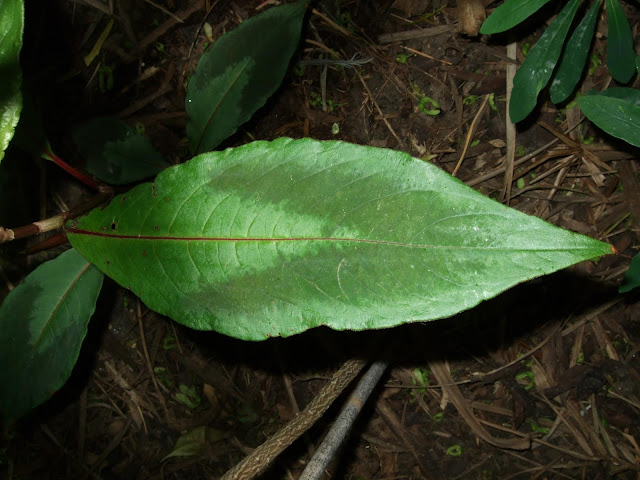 |
| Persicaria virginiana 'Compton's Form' |
The Other Persicarias...
Persicarias belong to the Knotweed family which means they are related to the dreaded Japanese Knotweed (Fallopia japonica). This is a noxious and pernicious weed in the UK that is difficult to get rid off once it makes an appearance in your garden or property. It was introduced by the Victorians for it's beautiful foliage and architectural form. But in the absence of it's natural predator here and having a more favourable environment it has become rampant, colonising large areas in a short amount of time. There are laws and restriction now when it comes to the handling and management of this plant that is the bane of many gardeners.
But if you wish to walk on the more dangerous side, there are 'tamer' versions of this rather pretty weed...
Fallopia japonica 'Milk Boy'
A small growing, variegated form of the Japanese Knotweed that only grows up to 18 inches tall. The first flush of leaves in the spring is almost pure white with a pink blush and can stay like that for a week or so before green flecks gradually appear on the previously pure white leaves. Subsequent flushes are variegated green and white with random patterns. Because of the intensity of variegation it is best sited from dappled to full shade and keep an eye on slugs and snails which seems to adore devouring this (seemingly) delicate plant.
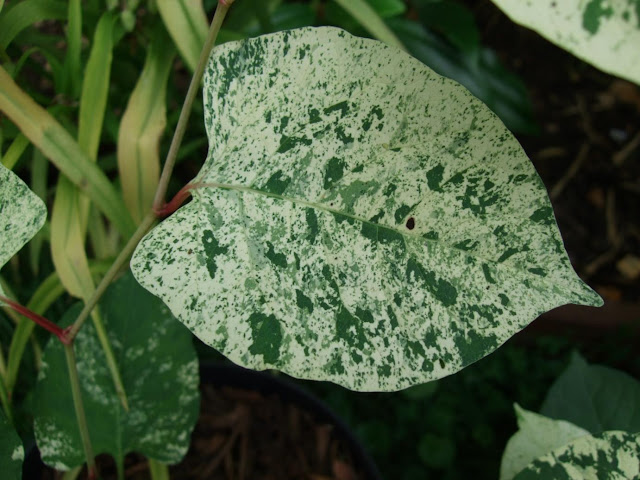 |
| Fallopia japonica 'Milk Boy' |
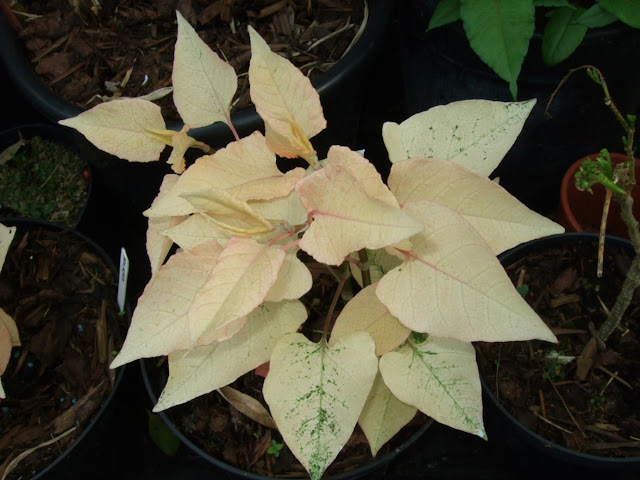 |
| Almost pure white with a pink blush in the spring |
Fallopia japonica 'Variegata'
This is the variegated form of the Japanese Knotweed hence the height and stature is pretty much the same as the plain green plant. However, most likely because of the variegation, it is not as vigorous and remains much, much tamer than its notorious sibling. The pattern of variegation on the leaves are not consistent and varies from leaf to leaf and can change appearance again throughout the growing season. The first flush of growth in the spring are tinged pink which gradually fades and you are left with white and green leaves. Once again, this is best sited in dappled to full shade to prevent scorching.
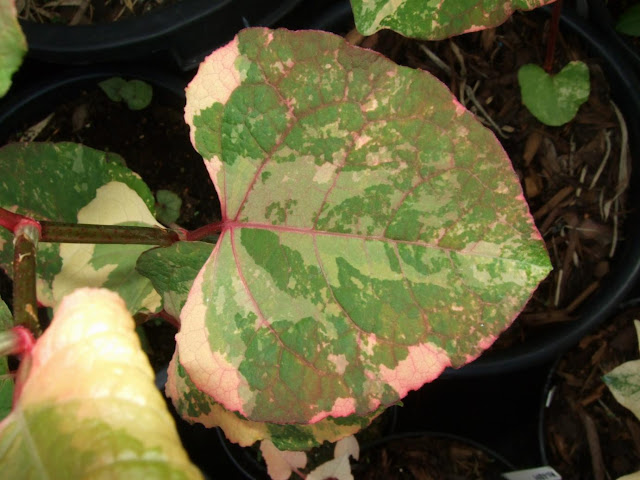 |
| Fallopia japonica 'Variegata' |
The two plants above are rarities that appeal more to plant collectors and is best handled only by experienced gardeners who are able to keep an eye on them if they ever start to run (and can deal with it accordingly). And if you ever get hold of one they are best kept in pots just to be sure and they don't seem to mind it as long as they are not allowed to dry out.
Pretty, painted, persicarias! If you are thinking of getting new plants for the coming season that will add extra interest to your planting scheme then some of these are worth considering. And most of them are not difficult to get hold of. Chances are, you may even have one or two already!
Mark :-)
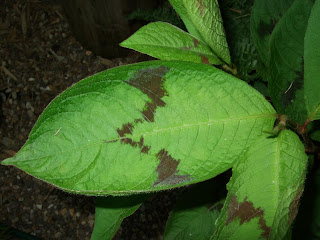
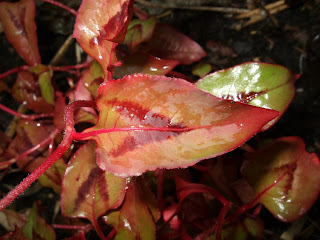
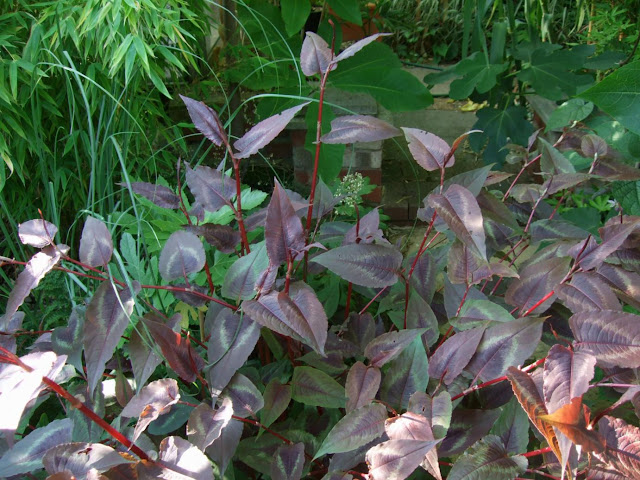
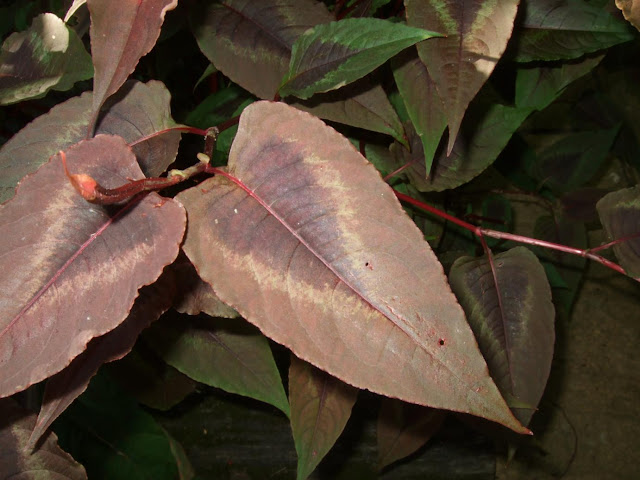
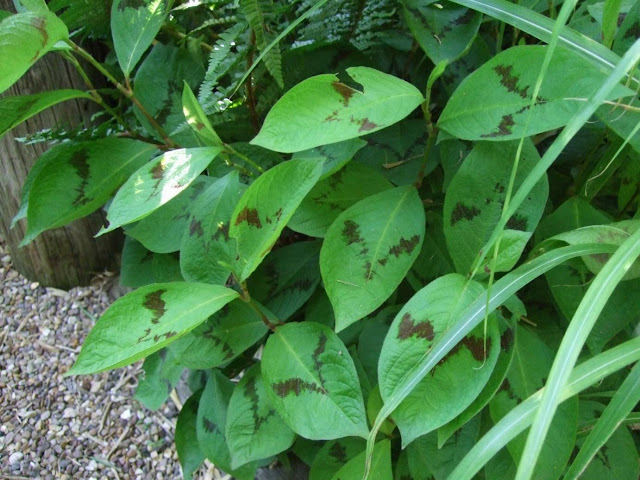

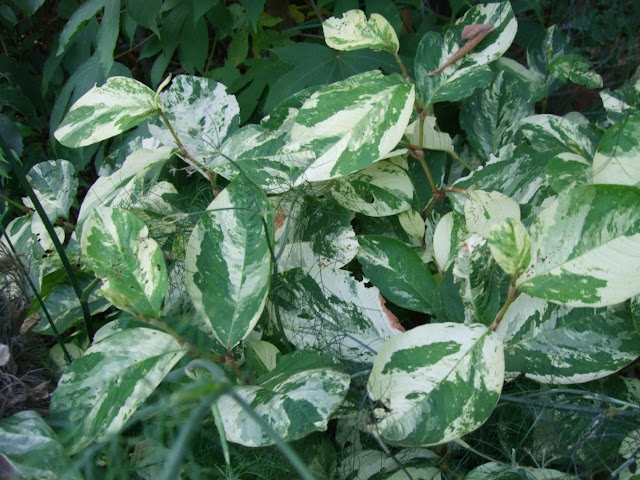
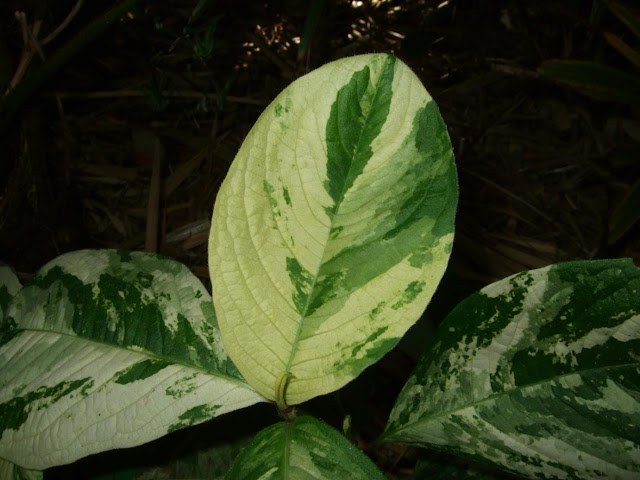
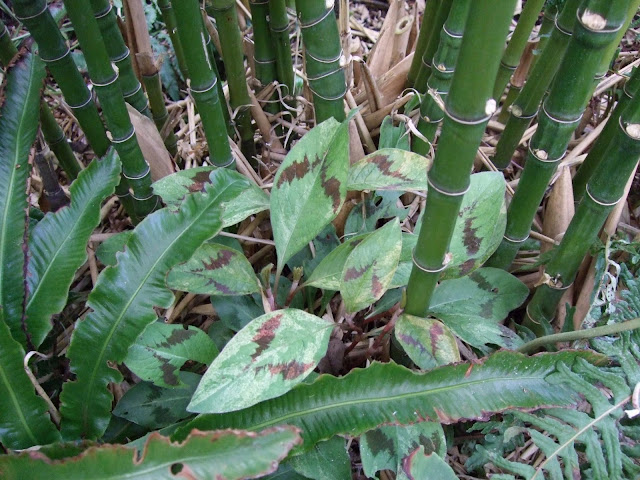
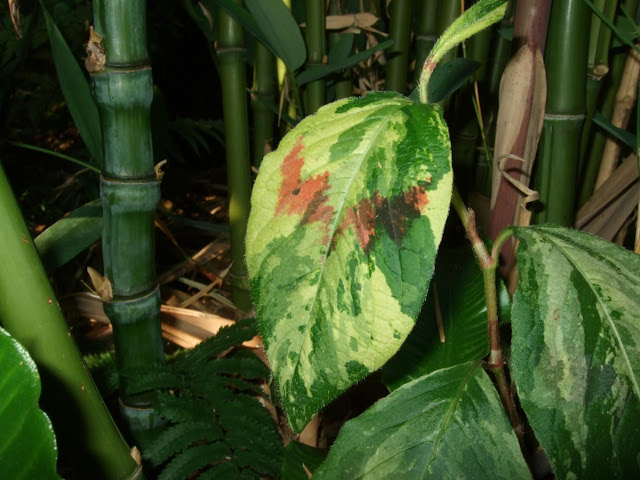
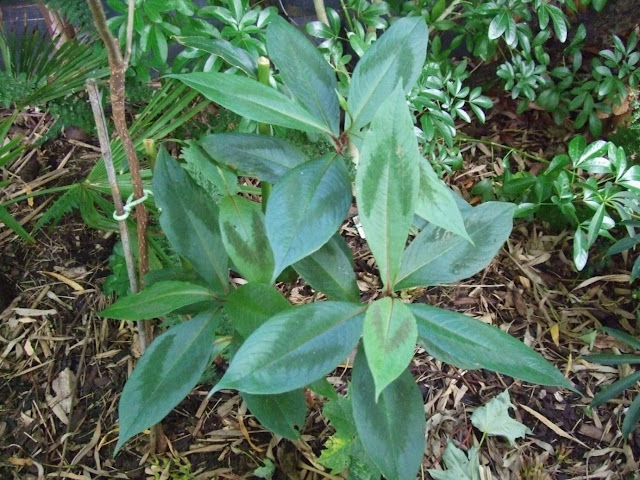
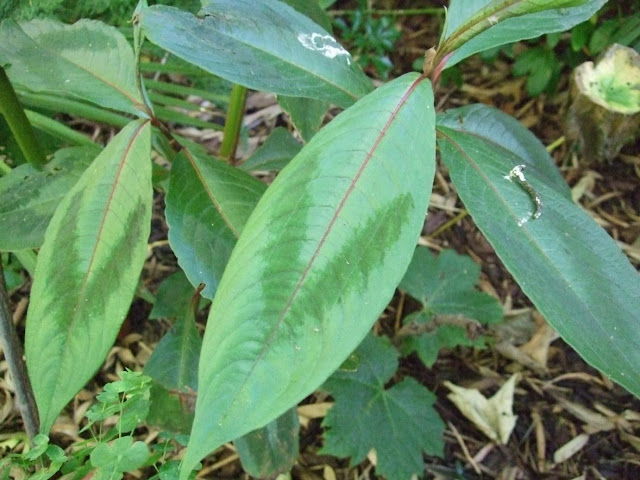
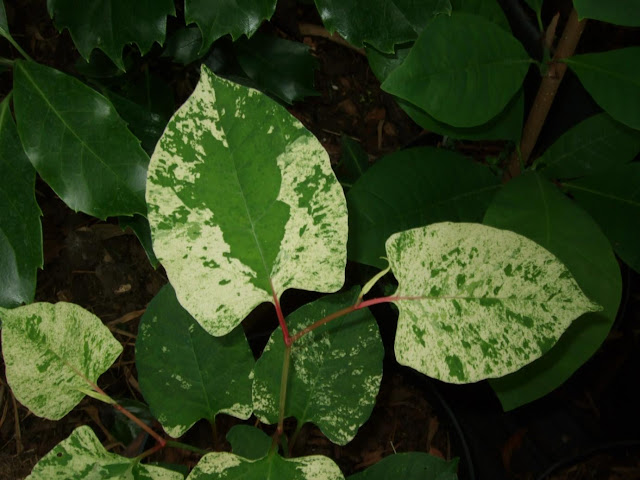
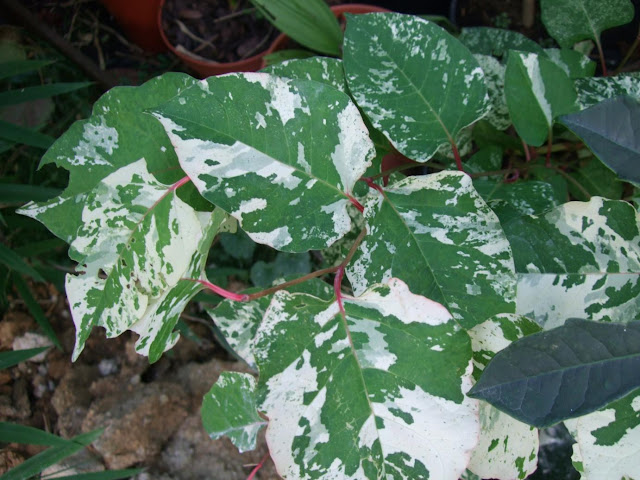
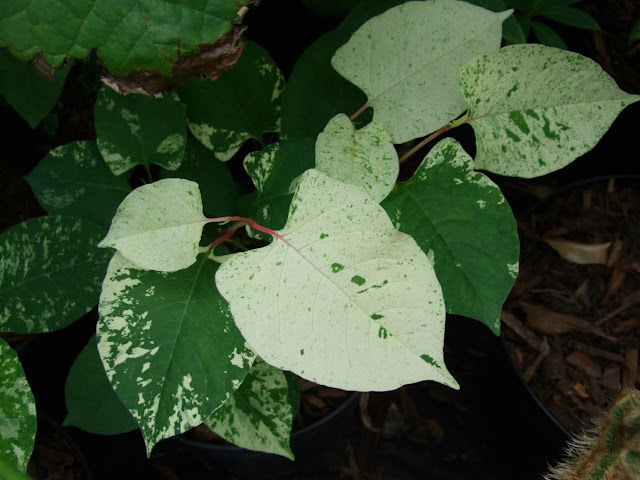
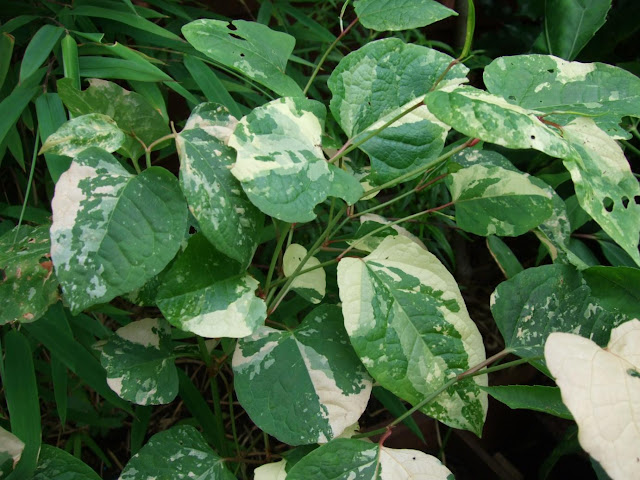
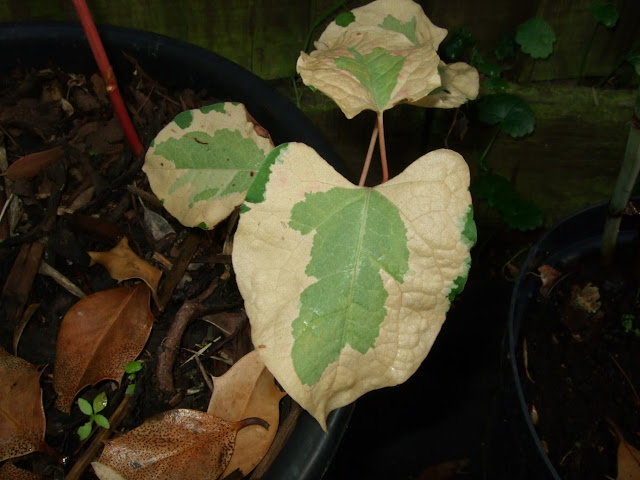
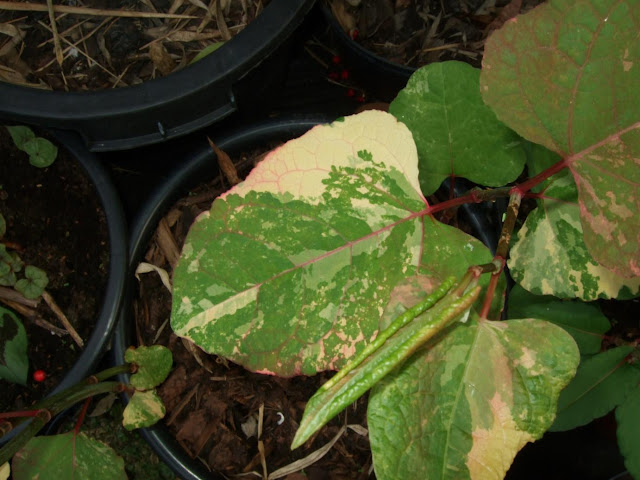

 This gardening blog follows our journey as we create our Tropical and Exotic themed garden. We hope you'll enjoy the journey as much as we do. We started our Exotic Garden in 2005 and this site will show its development, as well as our travels, both abroad and within the UK to gardens, nurseries and friends.
This gardening blog follows our journey as we create our Tropical and Exotic themed garden. We hope you'll enjoy the journey as much as we do. We started our Exotic Garden in 2005 and this site will show its development, as well as our travels, both abroad and within the UK to gardens, nurseries and friends.














Apart from the one you gave me I only have a couple of others including the weed Persicaria amplexicaulis 'Firetail'. I think you and I saw a huge plant of something similar to red dragon at Melissa's garden growing in front of a large bamboo and the combination was spectacular.
ReplyDeleteWow, I did not have the slightest idea that there is such a diversity of Persicarias out there. Around here one hardly ever sees them as garden plants.
ReplyDeleteWell don't I feel like a looser for only having one, and I don't even know what it is since it was a pass-along plant. If I do ever run across that Persicaria runcinata it will be mine, it's wonderful! Great post...I love to see what others are excited about!
ReplyDeleteI must admit I've never seen a persicaria in real life. I wonder why nobody grows them around here? Is it one of those egg-and-chicken things? I.e. is that nurseries don't carry them because people don't want them, or people don't want them because nurseries don't carry them?
ReplyDeleteBeautiful foliage plants for sure!
I love these plants and remember when you posted them last year and look forward to new shots this year. You know at first I thought that one had oil stains on it. LOL Really neat designs.
ReplyDeleteCher Sunray Gardens
P. runcinata gets my vote for its sensational leaf form. Nice post and I like them all. Unfortunately, these gems fade out in our intense summer heat. I guess that's why I never see them for sale here in Texas.
ReplyDeleteGreat post. Like you, I like foliage and form even better than flower blooms.
David/:0)
What a gorgeous post on foliage, I particularly love the shape of the Persicaria runcinata leaf...love! Nice to catch up with your blog, sorry its been so long! Cheers Julia
ReplyDeleteHi Don, I think I gave you a Kunming (?) but I can't remember for sure. More likely the persicaria we saw at Mels was Red Dragon and the combination did look great.
ReplyDeleteCollege Gardener, there are a few more available out there that I still have yet to acquire. Lovely set of plants although some can be very naughty too :)
Thanks Loree! I hope runcinata makes its way across the pond :)
Gerhard, I'm wondering as well. I know ones grown for their flowers are available there but the foliage ones are still few and far between. Perhaps there are restrictions to growing them there as some can be invasive in the right setting? Worth investigating! :)
Glad you like them Cher! I posted runcinata a few months ago in a mixed post but this time the persicarias take centre stage on their own :)
Thanks David! I suspect they don't thrive in areas that have high summer heat like in your area. I hope runcinata becomes more available in the US.
Hi Julia, looks like runcinata is proving popular :) Looking forward to your updates too!
The posts of your plant collections are my favourites. I can see why you collect these. They remind me of my Houttuynia cordata. I was convinced they were related but apparently not.
ReplyDeleteI was going to say that that your photos remind me of houttuynia too. That thug! Got it as a present in our last garden and it took off. it's probably half to Norway now... I'm sure your persicarias are much better behaved.
ReplyDeleteThanks b-a-g, Janet! Interesting enough I find it difficult to grow houttuynia in our garden, it never thrives and yet invasive on other gardens
ReplyDeleteI'm so attracted to a pretty bloom. Thanks for the reminder that I need more beautiful foliage. And these are as pretty as any bloom!
ReplyDeleteGlad you like them Holley! Foliage also plays an important role in the making of a pretty garden :)
ReplyDeletefantastic green variegations!
ReplyDeleteJust love 'Painter's Palette' around the base of that green stemmed bamboo!
ReplyDeleteWow! this Persicarias can indeed have such interesting leaves. Where did this plant come from? Is it native to the UK?
ReplyDeleteI love foliage variegations too, and yours are all exciting, nice for any foliage garden.
ReplyDeleteThanks Jen, Ian, Andrea, glad you liked them! Ian, I'm also pleased with that combination, that persicaria has been planted there for a few years now.
ReplyDeleteHi KL, some of them came from Asia, others possibly from North America :)
I still haven't got over calling these plants Polygonum. Never did have these ones with fabulous foliage though.
ReplyDeleteHi Alistair, thanks for reminding me of Polygonum, I've almost forgotten about the old genus. The name is still probably used on a smaller quantity of plants, and knowing how fickle botanists can be, they may reclassify and use that name again :)
ReplyDeleteThese are beautiful, I have a couple but after reading this post I want some more!!!
ReplyDeleteHi Mark,
ReplyDeleteit's Adrien from Germany. I did just some research on Persicarias on the net and i found you'r very interesting posting.
i grow "Red Dragon", "Painter's Palette", "Purple Fantasy" and "Filimormis" in my garden. your "Kunming" looks very interesting, where do you get it from?
Hope you'll see my messeage.
kind regards
Adrien
Hi Mark,
ReplyDeletei did just some research for Persicaria on the net and found your very interesting posting. i grow here in Germany, Mainz "Purple Fantasy", "Red Dragon", "Painter's Palette" and "Filiformis", like "Silver Dragon", i like very much your "Kunming", where do you get it from? do you think it is hardy as "Red Dragon".
i hope you'll read my message.
kind regards
Adrien